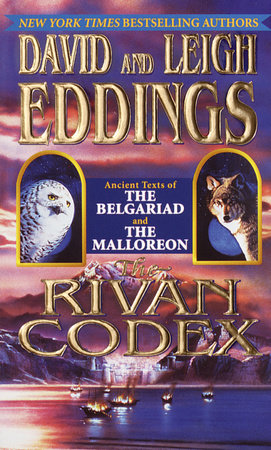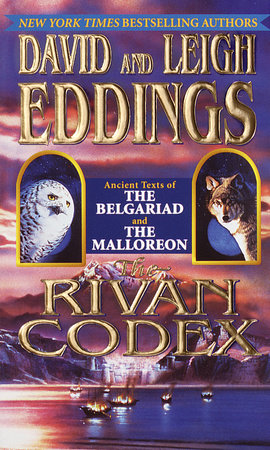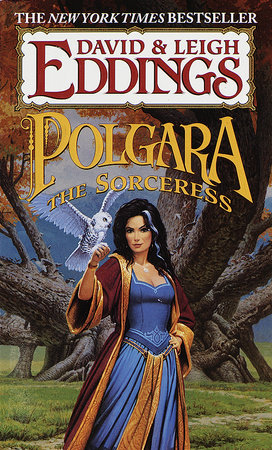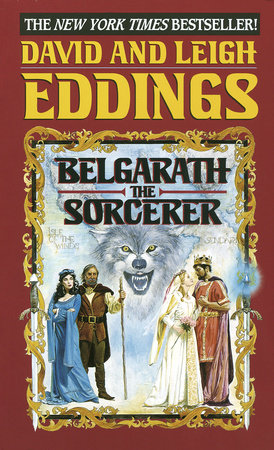Excerpt
The Rivan Codex
My decision to publish this volume was made in part because of a goodly
number of flattering letters I've received over the past several years.
Some of these letters have come from students at various levels, and to
make matters worse, I've also received letters from teachers who inform me that they're actually encouraging this sort of thing. Aren't they aware that they're supposed to wait until I'm safely in the ground before they do this?
The students, naturally, ask questions. The teachers hint around the edges of an invitation to stop by and address the class. I'm very flattered, as I mentioned, but I don't write--or grade--term papers any more, and I don't travel. To put it idiomatically, 'I ain't going no place; I been where I'm going.'
Then there are those other letters, the ones which rather bashfully
confide an intention to 'try writing fantasy myself'. I don't worry too
much about those correspondents. They'll get over that notion rather
quickly once they discover what's involved. I'm sure that most of them
will eventually decide to take up something simpler--brain surgery or
rocket science, perhaps.
I'd more or less decided to just file those letters and keep my mouth
shut. A prolonged silence might be the best way to encourage a passing
fancy to do just that--pass.
Then I recalled a conversation I had with Lester del Rey on one occasion. When I'd first submitted my proposal for the Belgariad, I'd expected the usual leisurely reaction-time, but Lester responded with what I felt to be unseemly haste. He wanted to see this thing--now, but I wasn't ready to let him see it--now. I was in revision of what I thought would be Book I, and since I was still doing honest work in those days, my time was somewhat curtailed. I wanted
to keep him interested, however, so I sent him my 'Preliminary Studies'
instead--'So that you'll have the necessary background material.' Lester
later told me that while he was reading those studies, he kept telling
himself, 'There's no way we can publish this stuff,' but then he admitted, 'but I kept reading.' We were fairly far along in the Belgariad when he made this confession, and he went on to say, 'Maybe when we've got the whole story finished, we might want to think about releasing those studies.'
Eventually, the two ideas clicked together. I had people out there asking questions, and I had the answers readily at hand since nobody in his right mind takes on a multi-book project without some fairly extensive preparation. My Preliminary Studies were right there taking up space, I'd just finished a five-book contract, and I had nothing else currently on the fire. All this thing needed was a brief
introduction and some footnotes, and we were off to press. (Just in
passing I should advise you that my definition of 'brief' and yours might differ just a bit. It takes me a hundred pages just to clear my throat. Had you noticed that? I thought you might have.)
Please bear in mind the fact that these studies are almost twenty years
old, and there are going to be gaps. There are places where some great
leaps occurred, frequently flowing out of the point of my pen during that actual writing, and I wasn't keeping a diary to report these bursts of inspired creativity. I'll candidly admit that probably no more than half of these 'strokes of genius' actually worked. Some of them would have been disastrous. Fortunately, my collaborator was there to catch those blunders. Trial and error enters into any form of invention, I suppose. This book may help others to avoid some of the missteps we made along the way, and it may give the student of our genre some insights into the creative process--something on the order of 'connect wire A to wire B. Warning! Do not connect wire A to wire C, because that will cause the whole thing to blow up in your face.'
Now that I've explained what I'm up to here, let's get the lecture out of the way. (Did you really think I'd let you get away without one?)
After I graduated from the US Army in 1956, one of my veteran's benefits
was the now famous GI Bill. My government had decided to pay me to go to
graduate school. I worked for a year to save up enough for some
incidentals (food, clothing, and shelter) and then enrolled in the
graduate school of the University of Washington in Seattle. (A good day in Seattle is a day when it isn't raining up.) My area of concentration was supposed to be modern American fiction (Hemingway, Faulkner, and
Steinbeck), but I had those Ph.D exams lurking out in the future, so I
knew that I'd better spend some time with Chaucer, Shakespeare, and Milton as well. Once I'd mastered Middle English, I fell in love with Chaucer and somewhat by extension with Sir Thomas Malory.
Since what is called 'Epic Fantasy' in the contemporary world descends in an almost direct line from medieval romance, my studies of Chaucer and Malory gave me a running head start in the field. 'Medieval Romance' had a long and honorable history, stretching from about the eleventh century to the sixteenth, when Don Quixote finally put it to sleep. It was a genre that spoke of the dark ages in glowing terms, elevating a number of truly barbaric people to near sainthood. The group that is of most interest to the English-speaking world, of course, is King Arthur and his knights of the Round Table. There may or may not have been a real King Arthur, but that's beside the point. We should never permit historical reality to get in the way of a good story, should we?
Since the issue's come up, though, let's take a look at someone who was
historically verifiable and who had a great deal of impact on the
fledgling genre in its earliest of days. The lady in question was the
infamous Eleanor of Aquitaine.
Eleanor was related to five (count 'em) different kings (or pseudo-kings) during the twelfth century. Her father was the Duke of Aquitaine (now known as Gascony) and, since he controlled more land than the King of France, he routinely signed official documents as 'the King of Aquitaine'. In 1137, Louis of France arranged a marriage between his son, Prince Louis and 'princess' Eleanor. Eleanor wasn't a good wife, since she had what's politely known as a 'roving eye'. Evidently, it was more than her eye that roved.
Her husband, who soon became Louis VII of France, was a pious man, and his wandering wife not only failed to produce an heir to his throne, but also became notorious as an adulteress. He finally managed to have their
marriage annulled in 1152, and two months later Eleanor married Henry
Plantagenet, Duke of Normandy, who incidentally also happened to be King
Henry II of England. Eleanor, as it turned out, was not barren, and she
bore Henry several sons. Aside from that, Henry and Eleanor didn't really get along together, so he took the easy way out and locked her up to keep her out of his hair. After he died, Eleanor stirred up trouble between her sons, Richard the Lionhearted and John the Incompetent, both of whom became kings of England. They also locked Mother away to keep her out of mischief.
Thus, Eleanor spent a lot of her time locked up. Embroidery didn't thrill her too much, so she read books. Books were very expensive in the twelfth century because they had to be copied by hand, but Eleanor didn't care. She had money, if not freedom, so she could afford to pay assorted indigents with literary pretensions to write the kind of books she liked. Given Eleanor's background it's understandable that she liked books about kings, knights in shining armor, pretty young fellows who played the lute and sang of love with throbbing emotion, and fair damsels cruelly imprisoned in towers. Her literary tastes gave rise to troubadour poetry, the courtly love tradition, and whole libraries of interminable French romances that concentrated heavily on 'The Matter of Britain' (King Arthur et al) and 'The Matter of France' (Charlemagne and Co.).
Now we jump forward three hundred years to the Wars of the Roses. There was a certain knight named Sir Thomas Malory (probably from Warwickshire) who sided with the Lancastrians. When the Yorkist faction gained the ascendancy, Sir Thomas was clapped into prison. He was not, strictly speaking, a political prisoner, however. He was in prison because he belonged there, since it appears that he was a career
criminal more than a political partisan. There may have been some politics involved in the various charges leveled against him, of course, but the preponderance of evidence suggests that he was a sort of medieval Jesse James, leading a gang of outlaws on a rampage through southern England. He was imprisoned for sedition, murder, the attempted murder of the Duke of Buckingham, cattle-rustling, horse theft, the looting of monasteries, jail-breaking and not infrequently of rape. Sir Thomas seems to have been a very bad boy.
He was still a nobleman, however, and a sometime member of parliament, so he was able to persuade his jailors to let him visit a nearby library
(under guard, of course). Sir Thomas was quite proud of his facility in
the French language, and he whiled away the hours of his incarceration
translating the endless French romances dealing with (what else?) King
Arthur. The end result was the work we now know as Le Morte d'Arthur.
A technological break-through along about then ensured a wide distribution of Malory's work. William Caxton had a printing press, and he evidently grew tired of grinding out religious pamphlets, so, sensing a potential market, he took Malory's manuscript and edited it in preparation for a printing run. I think we underestimate Caxton's
contribution to Le Morte d'Arthur. If we can believe most scholars,
Malory's original manuscript was pretty much a hodgepodge of disconnected tales, and Caxton organized them into a coherent whole, giving us a story with a beginning, a middle, and an end.







